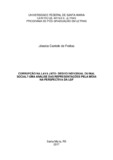| dc.creator | Freitas, Jéssica Cantele de | |
| dc.date.accessioned | 2018-08-30T20:44:42Z | |
| dc.date.available | 2018-08-30T20:44:42Z | |
| dc.date.issued | 2017-12-13 | |
| dc.identifier.uri | http://repositorio.ufsm.br/handle/1/14137 | |
| dc.description.abstract | This paper aims to investigate the representations of the term “corruption” in Operation Lava Jato contexts, using a contextual, lexicogrammar and semantic-discursive perspectives. To do such, theoretical principles of Systemic Functional Linguistics were used, specifically, the transitity system (HALLIDAY; MATTHIESSEN, 2014), Appraisal (MARTIN; WHITE, 2005) and as well as the representation of social actors (VAN LEEUWEN, 1997). The corpus of this research is composed of twenty (20) texts, whose main topic is the Operation Lava Jato and that present the term “corruption” at least four times. Such texts, available at Observatório da Imprensa, were published between March 2014 to August 2016 and were written by various authors. The methodology adopted is comprised of two stages: contextual analysis and linguistic analysis. The former consists of identifying the context of culture and the context variables of each text. The latter regards the linguistic analysis, unfolded as it follows: a) selection of clauses that present the term “corruption” and its referents; b) transitivity system analysis, in order to prove the representation of the role played by the term “corruption”; c) analysis of Appraisal to identify the evaluative representations; d) representations of social actors analysis, so that one can identify if the term is represented actively or passively; e) semantic systematization and categorization of the results. Such results showed representations to “corruption” that can be grouped into ten (10) semantic categories: it is; actions related to it; consequences; those involved; those affected; origin; feelings triggered by it; actions as consequences of it; attitudes to its end; and motive. One can conclude that “corruption” is approached in many ways. However, as to the character of those involved, the majority of the representations related to the phenomenon of corruption is neither individual nor social, it is of institutional character and it is intrinsic to the political system. | eng |
| dc.description.sponsorship | Coordenação de Aperfeiçoamento de Pessoal de Nível Superior - CAPES | por |
| dc.language | por | por |
| dc.publisher | Universidade Federal de Santa Maria | por |
| dc.rights | Attribution-NonCommercial-NoDerivatives 4.0 International | * |
| dc.rights.uri | http://creativecommons.org/licenses/by-nc-nd/4.0/ | * |
| dc.subject | Linguística sistêmico-funcional | por |
| dc.subject | Sistema de transitividade | por |
| dc.subject | Representação dos atores sociais | por |
| dc.subject | Sistema de avaliatividade | por |
| dc.subject | Corrupção | por |
| dc.subject | Systemic functional linguistics | eng |
| dc.subject | Transitivity system | eng |
| dc.subject | Representation of social actors | eng |
| dc.subject | Appraisal | eng |
| dc.subject | Corruption | eng |
| dc.title | Corrupção na Lava Jato: desvio individual ou mal social? Uma análise das representações pela mídia na perspectiva da LSF | por |
| dc.title.alternative | Corruption in Operation Lava Jato: individual deviation or social illness?? An analysis of representations by the media through SFL | eng |
| dc.type | Dissertação | por |
| dc.description.resumo | Este trabalho tem como propósito investigar as representações do termo corrupção no contexto da Operação Lava Jato, por meio de análise contextual, léxico-gramatical e semântico-discursiva. Para isso, toma-se por base os preceitos teóricos da Linguística Sistêmico-Funcional, mais especificamente do sistema de transitividade (HALLIDAY; MATTHIESSEN, 2014), do sistema de avaliatividade (MARTIN; WHITE, 2005) e da representação dos atores sociais (VAN LEEUWEN, 1997). O corpus da pesquisa é constituído por 20 textos, que têm como temática a Operação Lava Jato e apresentam o termo “corrupção” ao menos quatro vezes. Os textos, veiculados na página Observatório da Imprensa, foram publicados durante o período de março de 2014 a agosto de 2016 e foram produzidos por autores variados. O percurso metodológico adotado desenvolve-se em duas etapas: análise contextual e análise linguística. A primeira etapa consistiu em identificar o contexto de cultura e as variáveis contextuais que perpassam os textos. A segunda etapa referiu-se à análise linguística, com o intuito de constatar as representações para o termo “corrupção”, desenvolvida nos seguintes passos: a) seleção das orações que contêm o termo “corrupção” e seus referentes; b) análise do sistema de transitividade, a fim de constatar a representação do papel exercido pelo termo “corrupção”; c) análise do sistema de avaliatividade para identificar as representações avaliativas; d) análise das representações dos atores sociais, a fim de identificar se o termo é representado ativa ou passivamente; e) sistematização e categorização semântica dos resultados. Os resultados evidenciaram as representações para a corrupção agrupadas em 10 categorias semânticas: ela é; ações relacionadas a ela; consequências; envolvidos; afetados; origem; sensações que causa; ações acarretadas sobre ela; atitudes para seu fim; e motivo. Com os resultados, conclui-se que a corrupção é abordada de forma variada, entretanto, no que concerne ao caráter dos envolvidos, predomina a representação de que o fenômeno da corrupção não é nem individual, nem social; ele é de caráter institucional e está entranhado no sistema político. | por |
| dc.contributor.advisor1 | Cabral, Sara Regina Scotta | |
| dc.contributor.advisor1Lattes | http://lattes.cnpq.br/9037816308995897 | por |
| dc.contributor.referee1 | Souza, Vilmar Ferreira de | |
| dc.contributor.referee1Lattes | http://lattes.cnpq.br/0429355905988955 | por |
| dc.contributor.referee2 | Fuzer, Cristiane | |
| dc.contributor.referee2Lattes | http://lattes.cnpq.br/5169963931397212 | por |
| dc.creator.Lattes | http://lattes.cnpq.br/2428283842807938 | por |
| dc.publisher.country | Brasil | por |
| dc.publisher.department | Letras | por |
| dc.publisher.initials | UFSM | por |
| dc.publisher.program | Programa de Pós-Graduação em Letras | por |
| dc.subject.cnpq | CNPQ::LINGUISTICA, LETRAS E ARTES::LETRAS | por |
| dc.publisher.unidade | Centro de Artes e Letras | por |



